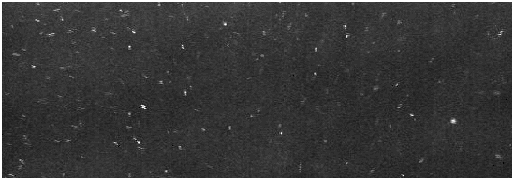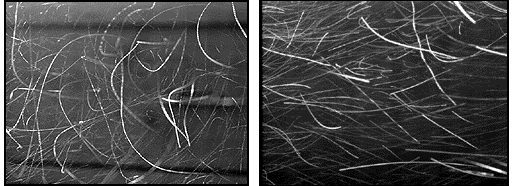 by Glen Southworth Chances are that you are looking at dust right now. The average computer display is a great attraction due to the high voltage used to light up the desktop screen. Frequently the only indication is a gradual dimming of the screen as a fine layer of dust gradually builds up. If you wear glasses and forget to wipe them off you also may be looking through something like our first illustration, an eight hour deposit of tiny particles which resulted from leaving these indispensable optical items at bedside. There's a bright side to dust watching that starts with one of the magic moments of childhood. A shaft of morning sun illuminates a miniature universe of floating tiny points of light, some brighter than others. If you are lucky a few may even appear in color. Reaching out to touch even one of these fairy worlds sets off a flurry of activity as miniature stars move hurriedly in many directions when air currents are disturbed. Recently faint memories were revived through courtesy of a perfect beam of light coming through the window from a Colorado sunrise. Having a television camera handy I focused on a small cloud of bright particles outlined against a dark background in order to magnify the tiny points of light for greater visibility on a fourteen inch screen. The next step was to use a video "frame grabber" to stop the continuous motion seen by the television camera. The initial results produced by capturing a single frame of video at one thirtieth of a second are shown in our second illustration and sort of resemble something that you might expect to see on a clear night sky.
 Next came the big experiment. Flipping a switch on the special video memory changed the monitor display from a group of not too interesting dots to a fascinating display of miniature comets shooting off in all directions and angles depending upon the action of small air currents in the room. A two second time exposure made by the memory is shown in our third illustration which shows the paths taken by various particles as well as several anomalies for which the author has, as yet, no explanation. Unfortunately technical limitations prevent the actual showing of dynamic changes which are shown continuously on the monitor screen during the time exposure process. Whereas the dust paths in our third illustration tend to show rather casual perambulation with both vertical and horizontal movement the next picture indicates predominantly horizontal motion produced by gentle fanning of the area being viewed by the television camera. It's also important to note that all of the pictures in this article, with the exception of number one, were made with the camera looking at a three dimensional segment of space. As a result some particles may look larger and/or brighter due to their distance from the camera lens. A project to be looked forward to is the use of two cameras set up in a stereo configuration for display of depth information. A small CCTV camera costing less than one hundred dollars was used in this experiment together with a one inch "C" mount lens and a fourteen inch television monitor. Pictures are taken relatively close up in order to increase the apparent size of dust particles.. Setup is easy in terms of adjusting field of view, focus, and lens stop, but in order to see paths of movement, as shown in the previous three images, it is necessary to use a special video memory such as the one described in a preceding article "Bird Watching."
 Using an ordinary photographic camera seems feasible under certain circumstances as film is an integrating media capable of making time exposures under controlled conditions. Careful attention should be paid to lighting, particularly in using a backdrop as light absorbent as practical, and in the prevention of any stray light entering the camera lens. A certain amount of experimentation will be required in order to obtain optimum results but it seems feasible to obtain exposures of several seconds with the extra advantage of obtaining a sharper image than that produced by the TV system. The main problem is that film is an integrating media, period, and any background or stray light may cause over exposure. Finally, although dust seems to be a part of our lives, how do you coax it into that shaft of light that's needed for viewing? One approach is to leave out an old rag or perhaps a knit stocking in a location known to gather dust. This can sometimes be determined by looking around your location, particularly in corners that may have escaped the maid's attention. After a few days carefully pick up your catching device and carefully move it to the scene of operations. When everything is ready gently shake the rag/sock/whatever over the appropriate viewing area and watch. Glen Southworth has been experimenting with this special way of making Video time exposures for ten years. See more information on this subject at "Bird Watching."
|
